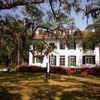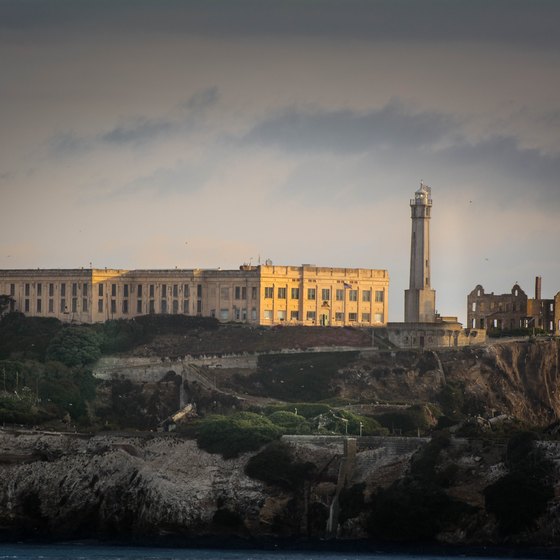Alcatraz Island, off the coast of San Francisco, holds a special place in American history. Most know it as the infamous and inescapable federal prison that held the worst of the worst, including gangsters, racketeers and kidnappers. But Alcatraz has a notable history both before and after its term as a federal lockup. That history includes the detention of Civil War-era traitors, wayward soldiers and, later, American Indian activists. Today visitors can witness that history firsthand: Alcatraz is part of the Golden Gate National Recreation Area.
Origins
Alcatraz gets its name from the Spanish explorer Juan Manuel de Ayala, according to the National Park Service. He sailed into the San Francisco Bay in 1775 and noticed many pelicans on a particular island. In mapping the landmarks he named that island La Isla de Alcatrices (Island of the Pelicans). That name, once Americanized to Alcatraz, stuck.
War History
Alcatraz became famous as a federal prison, but has its operational roots as a military fortress. In 1850 President Millard Fillmore declared Alcatraz a military fortress, and by 1859 the Union had stationed troops there in an effort to keep rebel sympathizers from overtaking the San Francisco Bay and bringing California into the Confederacy. The base was never attacked.
Military and Miscellaneous Prison
By 1865, the end of the Civil War, Alcatraz's weaponry had become obsolete. But the island itself was far from useless. In fact, wayward soldiers from around the country were being sent there to serve their time in military prison. Californians convicted of treason during the Civil War had also been sent there. Then, with the westward expansion of the United States, 19 Hopi Indians were sent to Alcatraz after a land dispute in northern Arizona in 1895. Alcatraz also housed military prisoners during and after the Spanish-American War, according to the National Park Service.
In 1915 the Army rethought its use of the prison, believing that having such a huge military penitentiary implied that soldiers were an unruly lot. The Army left the island in 1933.
Federal Prison
Alcatraz's history as a federal prison began in earnest in the early 1930s with an idea from U.S. Attorney General Homer Cummings. Cummings envisioned a special prison for the major criminals of that time—specifically kidnappers, racketeers and other predatory thieves and attackers, according to the National Park Service. Alcatraz, fearsome, remote and nearly impossible to escape, fit the bill. The prison opened in 1934 as a place to house the worst offenders from federal institutions around the country. James A. Johnston, a California businessman and experienced correctional officer and administrator, served as the first warden.
Famous Inmates
Alcatraz housed gangsters and high-profile thieves, some of the biggest celebrities of post-Depression-era America. Its most famous inmates included Chicago gangster Al Capone and bank robber/kidnapper George "Machine Gun" Kelly. Another inmate, convicted murderer Robert Stroud, became famous because of what he did in prison: he tended to birds and wrote two books on them and their diseases. The story inspired the 1951 Burt Lancaster film "The Birdman of Alcatraz."
Escape From Alcatraz
Inmates made 14 escape attempts in the 29 years that Alcatraz operated as a federal prison. According to the official record, no one has ever escaped from Alcatraz and found freedom. Escapees were either captured, shot or presumed drowned in the waters of San Francisco Bay, according to the site Alcatraz History.
The best-known escape was led by mastermind Frank Morris and recreated in the Clint Eastwood film "Escape from Alcatraz." It took place on June 11, 1962. Morris and his three partners spent months plotting an elaborate plan that included the use of crude dummy heads made from toilet paper, flesh-colored paint from prison art kits, and hair from the prison barbershop. The inmates planned to ride to freedom on a raft built from borrowed and stolen prison raincoats. Morris and two of his partners, brothers John and Clarence Anglin, were never found. Co-conspirator Allen West never made it out: his attempts to remove the air grate in his cell were unsuccessful.
Post-Prison
In November 1969 collegiate American Indian activists chartered a boat to Alcatraz and laid claim to the island, saying it had been taken from their people. They staged a full-scale occupation until June 1971, when federal authorities retook the island. The occupation is credited with giving rise to the "Red Power" movement, according to the National Park Service, and also with helping change the federal government's policy on American Indian tribes.
Alcatraz is currently maintained by the National Park Service as part of the Golden Gate National Recreation Area. Ferries to the island are operated privately, and the National Park Service recommends that visitors purchase their tickets well in advance.
References
Resources
Writer Bio
John Zaremba began writing professionally in 1997. He has worked at some of the country's finest small daily newspapers, including "The Beacon News" and "The Patriot Ledger." Zaremba is a graduate of the University of Illinois.





